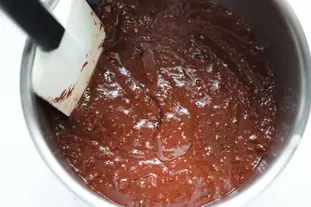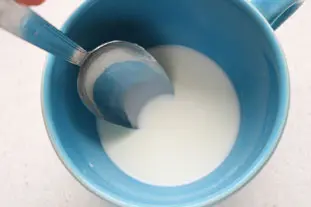This site uses only a few technical cookies necessary for its operation. By continuing to browse, you accept their use.
To find out more...
To find out more...
The dissociation of a preparation

It may have already happened to you: You prepare a sauce, a cream, a ganache etc. and then suddenly or almost, the whole thing dissociates, and from a smooth mixture that you were preparing with love, you end up with a horrible thing with a more or less solid part and another liquid part.
It's the dissociation, or as the french pastry chefs and cooks say, "it's tranché!".
It's the dissociation, or as the french pastry chefs and cooks say, "it's tranché!".
12 K 4.9/5 (13 reviews)
Keywords for this post:CreamSauceProblemDissociationSolidLiquidLast modified on: January 22th 2022
The dissociation of a preparation
For example, here is a chocolate-hazelnut ganache that is tranché:
It doesn't show up very well in the (small) photo, but there's a thick chocolate-hazelnut pan base, and on top a layer of liquid fat.
In the vast majority of cases, it's because in your mixture there is a fatty part and a watery part, the whole thing comes together in a delicate balance.
If this balance is broken because there is too much of one or the other, or a thermal shock, the whole which was homogeneous dissociates, it cuts!
This imbalance is often caused by the heating, perhaps excessive, of the preparation, and during this heating the water can evaporate and reduce, the fat not.
This is what happened with the ganache above, I didn't remove the simmering cream from the heat soon enough before adding the chocolate and hazelnut powder, sad result.
Another example, a bearnaise sauce or a hollandaise sauce that slices when it was almost finished, it's certainly because there was too much butter added and not enough water in the vinegar-wine-herb or lemon reduction.
And besides, it doesn't prevent this tragedy, there is little or no warning of disaster for an amateur, it is quite brutal.
1) Don't panic, don't despair, because it's very easy in this situation, so great is the disappointment, to swear a good big blow, to say to oneself that it's ruined, and to throw everything away...
2) Keep a critical eye: OK it's tranché, but what if it lacks water? Let's try to compensate it, and for that :
- Remove immediately from the heat or the water bath
- Add, very cold, a little bit of water (Béarnaise) or one of the components that brings it (cream for the ganache).
- Take the mixture back slowly, with a whisk, a spatula or a maryse to incorporate this addition (cross your fingers too, put all the chances on your side ;-).
3) If it still doesn't work, use the super power of cornstarch:
- Incorporate a mixture made of a tablespoon of water and a teaspoon of cornstarch in the preparation that you will put back on the fire and will whip until return of the initial texture.
You will have understood, there is no fatality in these small culinary dramas, it is just a bit of physics in your pan, it is necessary to try to be attentive enough during your preparation, to prevent rather than to cure.
To sum up: A preparation that goes off is most of the time an imbalance of water/fat, an imbalance that you can try to reduce or eliminate to regain the initial smoothness.

It doesn't show up very well in the (small) photo, but there's a thick chocolate-hazelnut pan base, and on top a layer of liquid fat.
What happened?
In the vast majority of cases, it's because in your mixture there is a fatty part and a watery part, the whole thing comes together in a delicate balance.
If this balance is broken because there is too much of one or the other, or a thermal shock, the whole which was homogeneous dissociates, it cuts!
This imbalance is often caused by the heating, perhaps excessive, of the preparation, and during this heating the water can evaporate and reduce, the fat not.
This is what happened with the ganache above, I didn't remove the simmering cream from the heat soon enough before adding the chocolate and hazelnut powder, sad result.
Another example, a bearnaise sauce or a hollandaise sauce that slices when it was almost finished, it's certainly because there was too much butter added and not enough water in the vinegar-wine-herb or lemon reduction.
And besides, it doesn't prevent this tragedy, there is little or no warning of disaster for an amateur, it is quite brutal.
What to do if it does?
1) Don't panic, don't despair, because it's very easy in this situation, so great is the disappointment, to swear a good big blow, to say to oneself that it's ruined, and to throw everything away...
2) Keep a critical eye: OK it's tranché, but what if it lacks water? Let's try to compensate it, and for that :
- Remove immediately from the heat or the water bath
- Add, very cold, a little bit of water (Béarnaise) or one of the components that brings it (cream for the ganache).
- Take the mixture back slowly, with a whisk, a spatula or a maryse to incorporate this addition (cross your fingers too, put all the chances on your side ;-).

3) If it still doesn't work, use the super power of cornstarch:
- Incorporate a mixture made of a tablespoon of water and a teaspoon of cornstarch in the preparation that you will put back on the fire and will whip until return of the initial texture.

You will have understood, there is no fatality in these small culinary dramas, it is just a bit of physics in your pan, it is necessary to try to be attentive enough during your preparation, to prevent rather than to cure.
To sum up: A preparation that goes off is most of the time an imbalance of water/fat, an imbalance that you can try to reduce or eliminate to regain the initial smoothness.
Lasts posts
Butter vs. grease
We often read in a recipe where a pastry is put into a mould that, just before pouring, the mould should be buttered or greased. But what's the difference between these 2 terms?December 1st 20256385
Getting out of the fridge early
Very often when you're cooking, you need to take food or preparations out of the fridge, to use them in the recipe in progress. There's nothing tricky about this: you just take them out of the fridge and use them, usually immediately, in the recipe. But is this really a good method?November 24th 20259495
Who's making the croissants?
When you look at a bakery from the outside, you naturally think that in the bakery, the bakers make the bread, and in the laboratory, the pastry chefs make the cakes. It's very often like that, with each of these professions having quite different ways of working, but sometimes there's also one...November 23th 2025855
Oven height
When we put a dish or cake in the oven, we naturally tend to put it on the middle shelf, and that's what we usually do. But in some cases, this position and height can be a little tricky, so let's find out why.October 8th 20252,4335
The importance of sieving
In recipes that use a fine powder (flour, powdered sugar, etc.), you'll often see the advice to sift before using it. To sift is to pass the powder in question through a sieve (a very fine strainer) before incorporating it into your recipe. It's often advice, but is it really useful?September 3rd 20257,3233
Other pages you may also like
Sausage broth
I've already talked to you about vegetable cooking water, which becomes a precious broth after cooking that would be a shame to throw away. Now let's look at the special case of meat cooking broth, and in particular sausages, which are often poached.June 28th 202312 K5
The 3 secrets of Parisian flan
A flan Parisien, or boulanger, is a simple yet delicious cake. A cream, a mixture of milk, eggs and sugar, is poured into a raw pastry base and baked in the oven until the pastry and cream are cooked. This is the simplest version of the recipe, probably the original one, but nowadays the cream...July 21th 202315 K4.7
Butter doesn't make you fat, unless you eat too much of it.
Whenever I'm discussing cooking and recipes, there is one idea which comes up frequently, like this: "Oh no! But that's got butter in it" (I should add, for the sake of accuracy, that this is something I hear more frequently from women, who are almost all concerned with keeping their figure). ...March 26th 201245 K4.5
Candied fruits: don't get ripped off
Do you like candied fruit? You might like to nibble a handful or add it to a recipe, like a classic fruit cake or delicious Italian specialities like panettone or sicilian epiphany pie.June 21th 201767 K 24.2
85 grams of eggs?
Some time ago, I already spoke to you about the difference between baking and pastry-making, I emphasized, among other things, the precision of pastry-making which requires grams, cm, degrees and minutes. That's why, on the one hand, you have baking and cooking, where a certain tolerance is...November 26th 201856 K4.6
Post a comment or question
Follow this page
If you are interested in this page, you can "follow" it, by entering your email address here. You will then receive a notification immediately each time the page is modified or a new comment is added. Please note that you will need to confirm this following.
Note: We'll never share your e-mail address with anyone else.
Alternatively: you can subscribe to the mailing list of cooling-ez.com , you will receive a e-mail for each new recipe published on the site.









